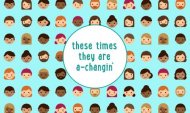 Over the past few years, there has been a noticeable shift in the world of advertising. In a new age that attempts to be politically correct and culturally sensitive, the public demands genderless design, racially diverse advertisement, and more achievable standards of beauty. Recently, long-time giant toy brand Mattel rolled out a new type of Barbie, with a variety of body shapes, sizes, and skin-tones. Why? Because their sales have been dropping for 7 straight quarters. I suppose their ridiculous-looking Barbie just doesn’t appeal to the average female consumer anymore. In fact, companies like ModCloth now proudly make it known they don’t use Photoshop to alter their models’ bodies into cartoonish figures. They even use models are who aren’t “industry standard” sizes – i.e., 5’10” tall with a 24” waist. What’s even more disturbing is that female models who are naturally thin and tall still get Photoshopped to hell, making even the most genetically-perfect woman still feel like she isn’t pretty or skinny enough.
Over the past few years, there has been a noticeable shift in the world of advertising. In a new age that attempts to be politically correct and culturally sensitive, the public demands genderless design, racially diverse advertisement, and more achievable standards of beauty. Recently, long-time giant toy brand Mattel rolled out a new type of Barbie, with a variety of body shapes, sizes, and skin-tones. Why? Because their sales have been dropping for 7 straight quarters. I suppose their ridiculous-looking Barbie just doesn’t appeal to the average female consumer anymore. In fact, companies like ModCloth now proudly make it known they don’t use Photoshop to alter their models’ bodies into cartoonish figures. They even use models are who aren’t “industry standard” sizes – i.e., 5’10” tall with a 24” waist. What’s even more disturbing is that female models who are naturally thin and tall still get Photoshopped to hell, making even the most genetically-perfect woman still feel like she isn’t pretty or skinny enough.
And women aren’t the only ones who suffer. Since the dawn of Photoshop, men also face unrealistic beauty standards, and are actually less likely to seek help than women when it comes to eating disorders. It’s such a prominent issue that even testosterone-fueled Axe Body Spray is attempting to appeal to the average, normal male.
 Want to go further down the rabbit hole? Now imagine taking all of these unrealistic beauty standards and apply them to people of color. Those bizzaro beauty standards simply become impossible. Imagine being a young black girl and rarely seeing someone who looks like you in a magazine ad or clothing commercial. In Kiri Davis’ short documentary, “A Girl Like Me”, the 1940 Clark Doll study is reenacted. Young black children are given identical black and white dolls to choose from. The result? 15 out 21 black children picked the white doll. Even just a few years ago, the majority of commercials rarely showed interracial couples. TV shows still sprinkle in a “token” dark-skinned actor, along with someone who is gay or a random Asian person to appear more culturally diverse. The truth is, if a TV show has too many minority actors, it becomes that type of show. White males are afforded the luxury of just being seen as people, and this ripple is felt all across the world.
Want to go further down the rabbit hole? Now imagine taking all of these unrealistic beauty standards and apply them to people of color. Those bizzaro beauty standards simply become impossible. Imagine being a young black girl and rarely seeing someone who looks like you in a magazine ad or clothing commercial. In Kiri Davis’ short documentary, “A Girl Like Me”, the 1940 Clark Doll study is reenacted. Young black children are given identical black and white dolls to choose from. The result? 15 out 21 black children picked the white doll. Even just a few years ago, the majority of commercials rarely showed interracial couples. TV shows still sprinkle in a “token” dark-skinned actor, along with someone who is gay or a random Asian person to appear more culturally diverse. The truth is, if a TV show has too many minority actors, it becomes that type of show. White males are afforded the luxury of just being seen as people, and this ripple is felt all across the world.
These sexist and racial issues stem much deeper than I can even elaborate in this short blog, but suffice it to say, we are entering an age where the word “family” is being redefined. Where women are seen as people instead of delicate, fragile females. Where companies are outed for their overuse of Photoshop and lack of diversity. People are tired of not seeing themselves reflected in advertising. The real world has real people in it – tall, short, thin, curvy, old, young, black, white, male, female, gay, straight, and everything in between.
Can advertising truly be totally inclusive? Probably not. There’s always going to be that one person who feels the need to jump on the politically correct bandwagon in an attempt to undermine what should be an important topic. Everyone is offended by something, right? But always remember the bigger picture: We, as a species, are trying to do better, to be better. We are constantly changing and adapting based on new information and discoveries. Advertising is attempting to take a very large step in the direction of healthy self-esteem and positivity. In the words of Bob Dylan, “These times they are a -changin’”, and in this designer’s opinion, it’s a great thing.










